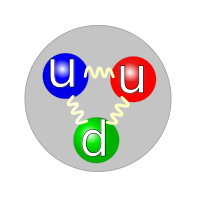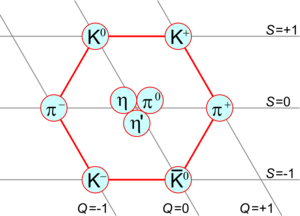قائمة الجسيمات
. . . . . . . . . . . . . . . . . . . . . . . . . . . . . . . . . . . . . . . . . . . . . . . . . . . . . . . . . . . . . . . . . . . . . . . . . . . . . . . . . . . . . . . . . . . . . . . . . . . . . . . . . . . . . . . . . . . . . . . . . . . . . . . . . . . . . . . . . . . . . . . . . . . . . . . . . . . . . . . . . . . . . . . .
الجسيمات الأولية
الجسيمات الأولية عبارة عن جسيمات لا تملك بنية داخلية (مقيسة) قابلة للقياس . بمعنى انها لا تتكون من بني جسيمية أدنى منها فهي غير مركبة مما هو ادنى بل تشكل كيانا مستقلا تتألف منه بقية العناصر المادية المركبة من ذرات و جزيئات و عناصر . طبعا هذا التعريف لا يعتبر ما يدعى بالأوتار في نظرية الاوتار الفائقة . تعتبر الجسيمات الأولية المكونات الأساسية ضمن نظرية الحقل الكمومي . يمكن تصنيف هذه الجسيمات حسب السبين حيث تملك بعض الجسيمات سبينا نصف صحيح half-integer فتدعى فرميونات والبعض الآخر تملك سبينا صحيحا فتدعى بوزونات .
النموذج العياري
 مقالة مفصلة: النموذج العياري للجسيمات
مقالة مفصلة: النموذج العياري للجسيمات
يمثل النموذج العياري أكثر الأشكال تكاملا لفهم فيزياء الجسيمات . جميع الجسيمات المذكورة في النموذج العياري تم رصدها تجريبيا باستخدام المسرعات باستثناء بوزون هيگز Higgs boson المسؤول عن قوة الثقالة .
الفرميونات
كواركات
 مقالة مفصلة: كوارك
مقالة مفصلة: كوارك
الجيل Name/Flavor شحنة كهربائية (e) الكتلة (MeV) الكوارك المضاد 1 علوي (u) +2/3 1.5 to 4 antiup quark سفلي (d) −1/3 4 to 8 antidown quark 2 غريب (s) −1/3 80 to 130 antistrange quark فاتن (c) +2/3 1,150 to 1,350 anticharm quark 3 قعري Buttom (b) −1/3 4,100 to 4,400 antibottom quark قمي TOP (t) +2/3 171,400 ± 2,100[1] antitop quark
ليبتونات
 مقالة مفصلة: ليبتون
مقالة مفصلة: ليبتون
- إلكترون و بوزيترون
- نيوترينو إلكتروني و نيوترينو مضاد إلكتروني
- ميون و ميون مضاد
- نيوترينو ميوني و نيوترينو مضاد ميوني
- تاو ليبتون و تاو ليبتون مضاد
- تاو نيوترينو و ناو نيوترينو مضاد.
بوزون (سبين صحيح)
 مقالة مفصلة: بوزون
مقالة مفصلة: بوزون
Name Charge (e) Spin Mass (GeV) Force mediated Photon 0 1 0 Electromagnetism W± ±1 1 80.4 Weak nuclear Z0 0 1 91.2 Weak nuclear Gluon 0 1 0 Strong nuclear Graviton 0 2 0 Gravity Higgs 0 0 >112 See below
جسيمات افتراضية
نظريات التناظر الفائق تتوقع وجود المزيد من الجسيمات، إلا أن لم يتأكد تجريبياً وجود أي منهم حتى عام 2009.
| Superpartner | Superpartner of | Spin | Notes |
|---|---|---|---|
| neutralino | neutral bosons | 1⁄2 | The neutralino is a superposition of the superpartners of neutral Standard Model bosons: neutral higgs boson, Z boson and photon. The lightest neutralino is a leading candidate for dark matter. The MSSM predicts 4 neutralinos |
| chargino | charged bosons | 1⁄2 | The chargino is a superposition of the superpartners of charged Standard Model bosons: charged higgs boson and W boson. The MSSM predicts two pairs of charginos. |
| photino | photon | 1⁄2 | Mixing with zino, neutral wino, and neutral Higgsinos for neutralinos. |
| wino,zino | W± and Z0 bosons | 1⁄2 | Charged wino mixing with charged Higgsino for charginos, for the zino see line above. |
| Higgsino | Higgs boson | 1⁄2 | For supersymmetry there is a need for several Higgs bosons, neutral and charged, according with their superpartners. |
| gluino | gluon | 1⁄2 | Eight gluons and eight gluinos. |
| gravitino | graviton | 3⁄2 | Predicted by Supergravity (SUGRA). The graviton is hypothetical, too - see next table. |
| sleptons | leptons | 0 | The superpartners of the leptons (electron, muon, tauon) and the neutrinos. |
| sneutrino | neutrino | 0 | Introduced by many extensions of the Standard Model, and may be needed to explain the LSND results. A special role has the sterile sneutrino, the supersymmetric counterpart of the hypothetical right-handed neutrino, called sterile neutrino |
| squarks | quarks | 0 | The stop squark (superpartner of the top quark) is thought to have a low mass and is often the subject of experimental searches. |
Note: Just as the photon, Z boson and W± bosons are superpositions of the B0, W0, W1, and W2 fields - the photino, zino, and wino± are superpositions of the bino0, wino0, wino1, and wino2 by definition.
No matter if you use the original gauginos or this superpositions as a basis, the only predicted physical particles are neutralinos and charginos as a superposition of them together with the Higgsinos.
Other theories predict the existence of additional bosons:
| Name | Spin | Notes |
|---|---|---|
| Higgs | 0 | Has been proposed to explain the origin of mass by the spontaneous symmetry breaking of the SU(2) gauge symmetry. SUSY theories predict more than one Higgs bosons. |
| graviton | 2 | Has been proposed to mediate gravity in theories of quantum gravity. |
| graviscalar | 0 | Also known as radion |
| graviphoton | 1 | Also known as gravivector[2] |
| axion | 0 | A pseudoscalar particle introduced in Peccei-Quinn theory to solve the strong-CP problem. |
| axino | 1⁄2 | Superpartner of the axion. Forms, together with the saxion and axion, a supermultiplet in supersymmetric extensions of Peccei-Quinn theory. |
| saxion | 0 | |
| branon | ? | Predicted in brane world models. |
| dilaton | 0 | Predicted in some string theories. |
| dilatino | 1⁄2 | Superpartner of the dilaton |
| X and Y bosons | 1 | These leptoquarks are predicted by GUT theories to be heavier equivalents of the W and Z. |
| W' boson | 1 | |
| Z' boson | 1 | |
| magnetic photon | ? | |
| majoron | 0 | Predicted to understand neutrino masses by the seesaw mechanism. |
| majorana fermion | 1⁄2 ; 3⁄2 ?... | Gluinos, neutralinos, or other |
Mirror particles are predicted by theories that restore Parity symmetry.
Magnetic monopole is a generic name for particles with non-zero magnetic charge. They are predicted by some GUTs.
Tachyon is a generic name for hypothetical particles that travel faster than the speed of light and have an imaginary rest mass.
Preons were suggested as subparticles of quarks and leptons, but modern collider experiments have all but ruled out their existence.
Kaluza-Klein towers of particles are predicted by some models of extra dimensions. The extra-dimensional momentum is manifested as extra mass in four-dimensional space-time.
- فوتينو
- علوينو
- گراڤيتينو
- بوزون گراڤيتون
- نيوترالينو
- نيوترينو معقم Sterile neutrino
- سليبتون
بوزونات إضافية :
جسيمات مركبة
. . . . . . . . . . . . . . . . . . . . . . . . . . . . . . . . . . . . . . . . . . . . . . . . . . . . . . . . . . . . . . . . . . . . . . . . . . . . . . . . . . . . . . . . . . . . . . . . . . . . . . . . . . . . . . . . . . . . . . . . . . . . . . . . . . . . . . . . . . . . . . . . . . . . . . . . . . . . . . . . . . . . . . . .
هادرونات
 مقالة مفصلة: هادرون
مقالة مفصلة: هادرون
باريونات (فرميونات)
- For a detailed list, see List of baryons.
 مقالة مفصلة: باريون
مقالة مفصلة: باريون
ميزونات (بوزونات)
 مقالة مفصلة: ميزون
مقالة مفصلة: ميزون
النويات الذرية

Atomic nuclei consist of protons and neutrons. Each type of nucleus contains a specific number of protons and a specific number of neutrons, and is called a nuclide or isotope. Nuclear reactions can change one nuclide into another. See table of nuclides for a complete list of isotopes.
الذرات
الجزيئات
--المادة المكثفة==
غيرهم
مصنف حسب السرعة
طالع أيضاً
- List of fictional elements, materials, isotopes and atomic particles
- جدول النيوكليدات
- قائمة الباريونات
- قائمة الميزونات
- خط زمني لاكتشافات الجسيمات
- قائمة المركبات لقائمة الجزيئات.
- الجدول الدوري for an overview of atoms.
- Standard Model for the current theory of these particles.
- أكسلرون
المصادر
- ^ "Top mass: now at 1.2% uncertainty". 2006-08-03. Retrieved 2006-10-15.
- ^ Roy Maartens, “Brane-World Gravity”, Living Rev. Relativity, 7, (2004), 7. [1], [2]








